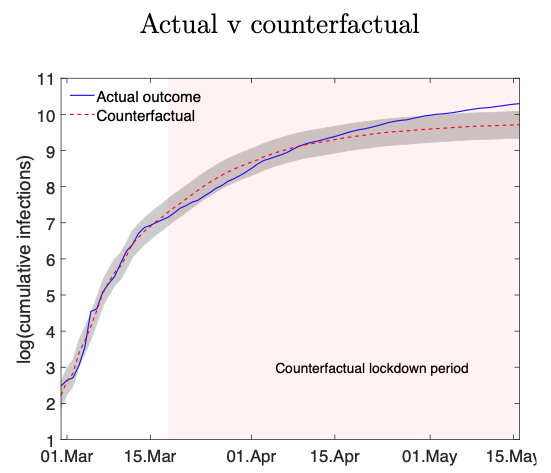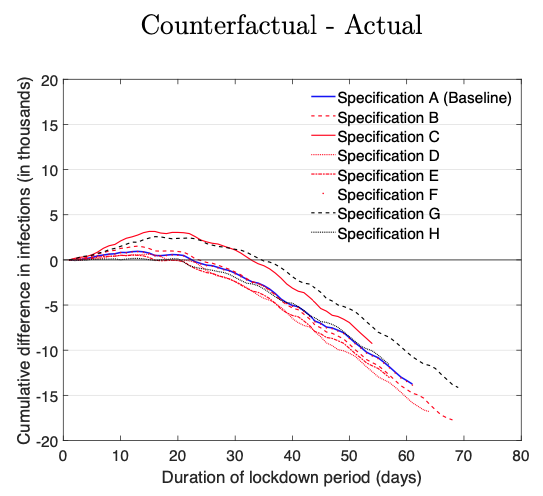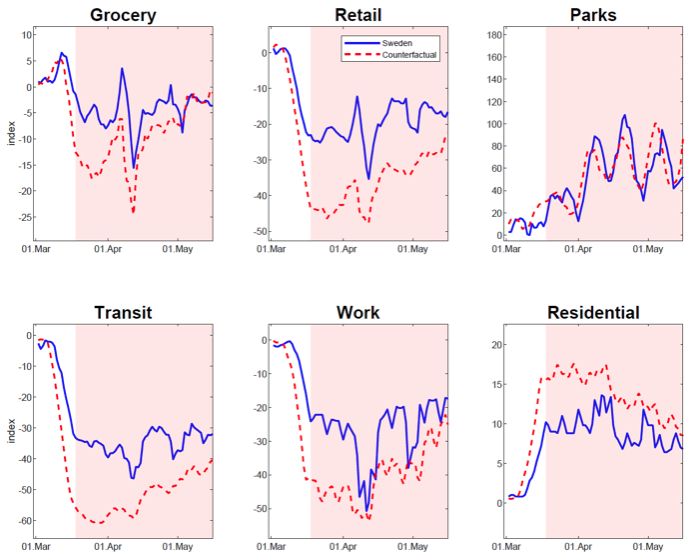In order to limit the spread of COVID-19, many countries were put under lockdown. Not least because of their severe economic and social costs (Miles 2020, Torrejón Pérez et al. 2020), it is important to quantify the extent to which lockdowns can actually limit COVID-19 infections and deaths. Theory, as well as early estimates, suggests that their beneficial impact can be large (Deb et al. 2020, Hsiang et al. 2020). But how large is it really? Answering this question is difficult because most countries imposed a lockdown and we cannot directly observe the counterfactual outcome.
In a new study, we exploit the fact that Sweden was the only country among its European peers that did not impose a lockdown (Born et al. 2020). Based on this peer group, we construct a synthetic control unit that approximates what would have happened had Sweden imposed a lockdown (Abadie et al. 2010). In constructing the control unit, we ensure that it resembles Sweden in terms of infection dynamics before the lockdown. The difference between the control unit and Sweden during the lockdown provides us with a measure of the lockdown effect.
Constructing a synthetic control unit to approximate a lockdown counterfactual for Sweden
Our results are based on an algorithm and a donor pool that includes 13 countries from Western Europe with at least 1 million inhabitants. All countries in the donor pool did impose a lockdown, but there are differences in terms of its timing and stringency, as well as in terms of infection dynamics. In order to initialise observations across countries, we define day 1 for each country as the day when the number of infections per one million inhabitants exceeds one. We find that it takes countries at least 13 days from day 1 to impose a lockdown.
Given the donor pool, we construct a synthetic control unit that resembles Sweden before the lockdown as closely as possible. Specifically, we select a weight for each of the 13 countries in the donor pool as we match log infections in Sweden during the first 13 days as well as its size in terms of population and its urbanisation rate. We find that five countries from the donor pool receive a non-negligible weight in the control unit: the Netherlands (39.1%), Denmark (26.1%), Finland (19.2%), Norway (14.6%), and Portugal (1%). The average outcome across the countries in the control unit approximates the counterfactual outcome against which we benchmark actual developments in Sweden. On average, it takes 18 days after day 1 before the a 60-day lockdown is imposed. Since day 1 in Sweden is 29 February 2020, we assume that the counterfactual lockdown runs from 18 March to 17 May.
The lockdown would have limited the spread of COVID-19 infections in Sweden considerably
Figure 1 COVID-19 infections in Sweden
Notes: Top panel: actual outcome (blue solid line) v counterfactual (red dashed line) in logs. Bottom: counterfactual – actual outcome since start of the lockdown period in thousands. Counterfactual approximated by outcome of control unit. Grey shaded area: two standard deviations of difference between infections in Sweden and control unit during the first 13 days. Pink shaded area: lockdown period (March 18–May 17). Specifications B-F: alternative control units based on restricted donor pools. Panel G: day 1 determined on the number of deaths, Panel H: control unit determined by matching number of deaths instead of log infections.
Data source: Johns Hopkins University (Dong et al., 2020).
The top panel of Figure 1 shows infection dynamics in Sweden (blue solid line) and the control unit that approximates the counterfactual outcome for Sweden (red dashed line). The vertical axis measures cumulative infections in logs, the horizontal axis represents calendar days. By construction, the control unit tracks infection dynamics closely during the matching period (day 1 to 13). We also obtain a good fit for population size (10.175 million in Sweden versus 10.187 in the control unit) and for the urbanisation rate (0.874 versus 0.877, respectively). Yet our procedure does not constrain infection dynamics during the lockdown period, indicated by the pink shaded area. The grey shaded area, in turn, represents two standard deviations of the difference between log infections in Sweden and the control unit during the matching period. It puts deviations between the actual outcome and the counterfactual into perspective, but it is not a formal test of statistical significance.
We observe that log infections in the lockdown counterfactual are considerably lower at the end of the lockdown period. Specifically, we find that during the counterfactual lockdown period there are 28,864 new infections in Sweden, compared to 15,108 in the counterfactual. This is our main result: a lockdown would have reduced the number of infections in Sweden by 48%. At the same time, it would have reduced the number of deaths by 34% (from 3,669 to 2,438). In our study we show that this result is not driven by any specific country in the control unit and that it is robust across a number of alternative specifications.
But the lockdown effect takes time to materialise
The bottom panel of Figure 1 shows the cumulative difference in infections between the counterfactual and the actual numbers for Sweden since the start of the lockdown. The blue solid line is the result for our baseline specification (shown in the top panel), the other lines pertain to alternative specifications for the control unit and the timing of day 1. A robust finding emerges across specifications: the lockdown effect emerges only with a considerable delay. In fact, initially Sweden is outperforming the control unit – the lockdown starts to slow down infections only after about 3 to 4 weeks. This is noteworthy because the incubation period for COVID-19 is on average only 5-6 days, and at most up to 14 days (WHO 2020).
We conjecture that it takes time for a lockdown effect to materialise because there is (voluntary) social distancing even in the absence of a lockdown. In order to explore this possibility, we compare actual mobility patterns in Sweden and the counterfactual on the basis of Google COVID-19 Community Mobility Reports. Locations are classified according to six distinct categories: ‘Work’, ‘Transit’, ‘Retail and Recreation’, ‘Grocery and Pharmacy’, ‘Parks’, and ‘Residential’. The reports measure the change in the number and the length of stays at these locations relative to the median value of the same weekday between 3 January and 6 February 2020.
Figure 2 displays mobility dynamics for each category, contrasting once more actual data for Sweden (blue solid line) and for the counterfactual (red dashed line), approximated by the same control unit as above. We measure observations using five-day symmetric averages along the horizontal axis, and report the percentage change relative to the pre-COVID-19 period. As before, the pink shaded area indicates the lockdown period. We observe, first, a pronounced decline of mobility in the four panels on the left. They provide a measure of activities associated with travel and work as well as shopping and dining in restaurants (‘recreation’). At the same time, people spend more time in parks and at home (right panels). Second, the adjustment starts to take place about 10 days before the lockdown and, in line with our conjecture, it can be observed both in terms of actual developments in Sweden as well as for the counterfactual.
Figure 2 Mobility patterns in Sweden: Actual outcome (blue solid line) versus counterfactual (red dashed line)
Notes: Vertical axis: percentage change relative to median in early 2020. Horizontal axis: five-day symmetric moving average. Pink shaded area indicates lockdown period. Construction of counterfactual: see Figure 1 (Specification A, Baseline).
Data source: Google mobility reports (Google 2020).
Conclusions
We find that a lockdown would have reduced the number of infections in Sweden by approximately 14,000 and the number of deaths by about 1,200. This effect obtains at the end of a lockdown which lasts for 8.5 weeks, but it takes time for this effect to become manifest. We rationalise this delay with the observation that even without a lockdown, there was considerable social distancing in Sweden – in line with the arguments of recent contributions that augment the basic SIR model to account for behavioural adjustments in the face of infection risk (Eichenbaum et al. 2020).
Yet the size of the lockdown effect suggests that there is a non-trivial infection externality – people fail to internalise the costs they impose on others as they become infectious and, hence, voluntary social restraint fails to deliver the same extent of social distancing that we observe for the lockdown scenario. Still, because our analysis is altogether silent on the costs of a lockdown, the final verdict on lockdowns as a policy tool is still out. We would hope that our results inform a broad-based debate on the best policy response to the COVID-19 pandemic.
References
Abadie, A, A Diamond, and J Hainmueller (2010), “Synthetic control methods for comparative case studies: estimating the effect of California’s tobacco control program”, Journal of the American Statistical Association 105(490): 493–505.
Born, B, A Dietrich, G Müller (2020), “The lockdown effect: A counterfactual for Sweden”, CEPR Discussion Paper 14744.
Deb, P, D Furceri, J D Ostry and N Tawk (2020), “The effect of containment measures on the COVID-19 pandemic”, VoxEU.org, 5 June.
Dong, E, H Du and L Gardner (2020), “An interactive web-based dashboard to track covid-19 in real time”, Lancet Infect Dis 20(5): 533–534.
Eichenbaum, M, S Rebelo and M Trabandt (2020), “The trade-off between economic and health outcomes of the COVID-19 epidemic”, VoxEU.org, 20 July.
Google (2020), Google COVID-19 Community Mobility Reports (accessed 1 July 2020).
Miles, D (2020), “The UK lockdown: Balancing costs against benefits”, VoxEU.org, 13 July.
Torrejón Pérez, S, M Fana, I González-Vázquez and E Fernández-Macías (2020), “The asymmetric impact of COVID-19 confinement measures on EU labour markets”, VoxEU.org, 9 May.
Hsiang, S, D Allen, S Annan-Phan et al. (2020), “The effect of large-scale anti-contagion policies on the COVID-19 pandemic”, Nature.
WHO (2020), Coronavirus disease 2019 (COVID-19) situation report – 73.








